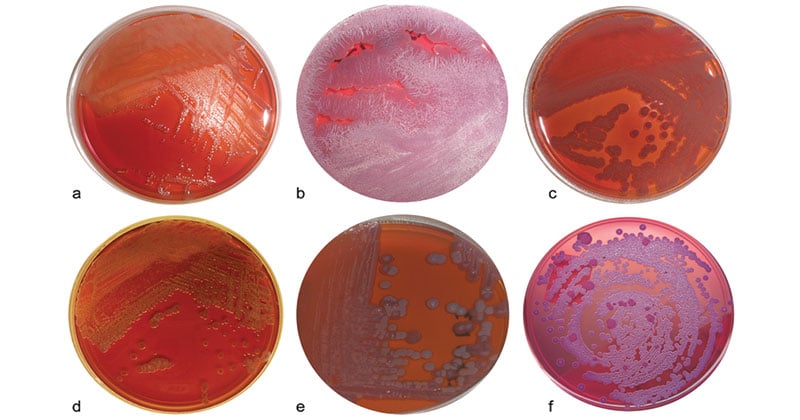- Ashdown’s medium is a selective culture medium for the isolation and characterization of Burkholderia pseudomallei (the bacterium that causes melioidosis).
- Ashdown’s medium was first described by LR Ashdown in 1979.

Interesting Science Videos
Composition of Ashdown’s Agar
| Ingredients | Gram/Litre |
| Tryptone soya broth | 10 g |
| Agar | 15 g |
| Glycerol | 40 ml |
| Gentamicin | 4 mg |
| Crystal violet 0.1% | 5 ml |
| Neutral Red 1% | 5 ml |
| Distilled water | 950ml |
Principle of Ashdown’s Agar
- The medium contains crystal violet and gentamicin as selective agents to suppress the growth of other bacteria.
- Colonies of B. pseudomallei also take up neutral red which is present in the medium, and this further helps to distinguish it from other bacteria.
- Gentamicin slightly inhibits the growth of B. pseudomallei and so specimens inoculated onto Ashdown’s agar needs to be incubated for a minimum of 96 hours instead of 48 hours.
- The medium is also enriched with 4% glycerol, which is required by some strains of B. pseudomallei to grow.
- At 24 hours of incubation of the medium colonies are often pinpoint, clear and pale pink, changing to become pinkish-purple, flat, and slightly dry in the next 2 days. The most characteristic feature of B. pseudomallei is its metallic sheen, and the usual progression to dry and wrinkled colonies at 96 hours.
Preparation and Method of Use of Ashdown’s Agar
- Mix all ingredients in a bottle.
- Autoclave at 121°C for 15 min.
- Cool to 50°C, add gentamicin to a final concentration of 4 mg/l
- Dispense the agar into petri-dishes.
Note: The crystal violet solution of 0.1% should be incubated at 37°C for two weeks before being used in order to ensure optimal coloration.
- Subculture 10 ml from the upper layer of the threonine-basal salt solution plus colistin 50 mg/L medium to an Ashdown agar plate in a BSC, streaking to achieve single colonies.
- Incubate the Ashdown agar plate at 40°C in air.
- Examine the Ashdown agar plate daily for 7 days in a BSC for colonies suspected to be of B. pseudomallei.
Result Interpretation of Ashdown’s Agar
| Organism | Growth |
| Burkholderia pseudomallei | Highly wrinkled circular purple colonies on ASA by 48 h |
| Burkholderia thailandensis | Circular purple colonies |
Uses of Ashdown’s Agar
- Ashdown’s selective agar (ASA) is the currently favored medium for the isolation and presumptive identification of B. pseudomallei in areas where melioidosis is endemic.
- It is used for the selective isolation of B. pseudomallei from clinical specimens taken from non-sterile sites (e.g., sputum) as well as to produce the characteristic morphology of B. pseudomallei.
Limitations of Ashdown’s Agar
- Further tests must be carried out for identification of B. pseudomallei. Any organism that has a colonial appearance typical of B. pseudomallei on Ashdown agar and is resistant to colistin and susceptible to co-amoxiclav can be presumptively identified as B. pseudomallei if it is positive for latex agglutination.
- It has been noted in local clinical laboratory use that ASA is inhibitory to some strains of B. pseudomallei.
- Isolation from sputum is particularly difficult when low numbers of B. pseudomallei are present and there is an abundant commensal upper respiratory tract flora.
References
- Howard, K., & Inglis, T. J. (2003). Novel selective medium for isolation of Burkholderia pseudomallei. Journal of clinical microbiology, 41(7), 3312-6.
- https://wikivisually.com/wiki/Ashdown%27s_medium
- https://www.revolvy.com/page/Ashdown%27s-medium
- https://www.researchgate.net/publication/7557561
- https://books.google.com.np/
- https://journals.plos.org/

hi, i have question.in ash down can other pseudomonas sp grow. if yes, what colour of the colony